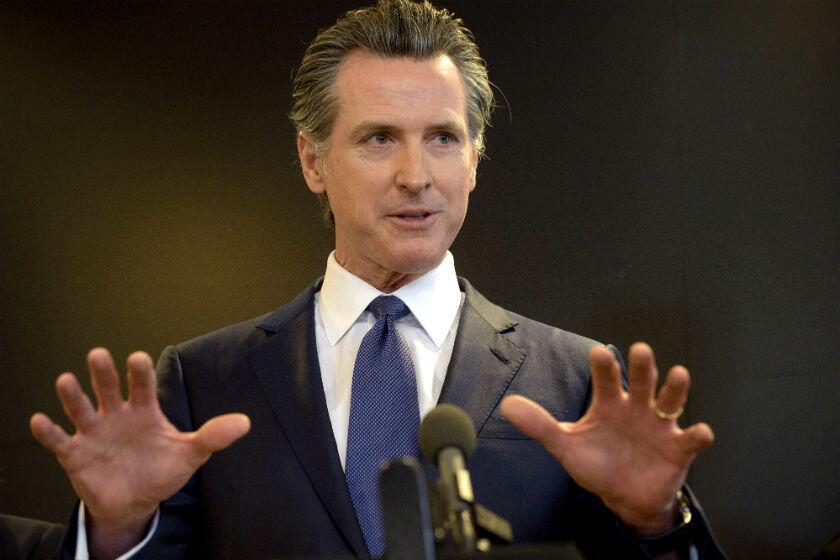Column: Income inequality is going to hit tomorrow’s retirees hard
- Share via
One of the mysteries of personal finance has been the disconnect between the income inequality afflicting the working public and the claims by fiscal conservatives that most people’s retirement lifestyles will be perfectly comfortable.
A recent post on the Squared Away blog of Boston College’s authoritative Center for Retirement Research solves the mystery. There is no disconnect between income inequality for the working class and what they’ll face in retirement: A flood tide of income inequality is awaiting today’s workers when they do retire, and we’re standing on the edge of the water.
The post is based on the center’s conclusion that 56% of all low-income households face the risk of being unable to maintain their pre-retirement standard of living once they stop working. For middle-income households, the figure is 54%, but for high-income households, it’s only 41%. In other words, fewer than half of all middle- and low-income households will be able to maintain their lifestyles in retirement, but nearly two-thirds of high-income households will.
Just as the wealth and income gap between the well-to-do and working people is growing, so too is retirement inequality.
— Center for Retirement Research, Boston College
The center posits several reasons for the mismatch. One is the rise of defined contribution retirement plans such as 401(k) plans, which have supplanted traditional defined benefit pensions for millions of workers, especially in the private sector.
Because defined contribution plans require workers to set aside part of their income for the future, it’s a bigger burden on low- and moderate-income families, which have less disposable income than their affluent colleagues. They’re also more likely to see their household finances upended by divorce, layoffs and unexpected medical bills.
Lower-income workers find it harder to work later in life, possibly because their options tend more toward physical work rather than desk jobs. That problem is compounded by an increase in Social Security’s normal retirement age to 67 (for those born in 1962 or later) from 65 (for those born in 1939 or earlier). The change means that workers taking retirement at age 65 will either have to wait before receiving their full Social Security benefits, or accept a lower monthly benefit at 65.
The change places an added burden on lower-income people because their life expectancy is shorter on average than wealthier retirees. The downsides of this well-documented trend include that spouses taking spousal benefits in middle- and low-income families could face a cut in their family benefits at an earlier age than better-heeled families.
“Just as the wealth and income gap between the well-to-do and working people is growing,” the center’s blog post observes, “so too is retirement inequality.”
The challenge facing today’s workers as they move into retirement shouldn’t be a surprise. After all, it’s unlikely that households suffering from increased income inequality throughout their working lives would suddenly find themselves on equal footing with wealthier workers once they retire.
Yet fiscal and political conservatives have waged a long campaign to persuade policymakers that the “retirement crisis” is a myth. They dispute the prospects of a deterioration in the standard of living for millions of future retirees by observing, among other things, that retirement assets held by Americans are at an all-time high. Andrew Biggs of the American Enterprise Institute, one of the leading torch-bearers of this argument, observed in 2015 that Individual Retirement Account balances and benefits due from traditional pensions and Social Security had risen from 2.7 times total personal incomes in 1996 to 4.1 times in early 2015.
Biggs asserted last year that Americans’ retirement income is consistently and appreciably understated, citing research by two Census Bureau economists. (Biggs’ goal was to persuade the Trump administration that it should “reconsider its pledge not to cut Social Security benefits,” since there was plenty of room to cut without harming retirees living high on the hog.)
There are two flaws in this mind-set. One is that estimates of overall retirement savings never acknowledge the distributional issue: Who is it that holds all those billions in assets residing in IRAs and 401(k) plans? The answer is that it’s the rich, whose disproportionately high share of retirement balances perfectly matches, even exceeds, their share of overall income.
As Monique Morrissey of the progressive Economic Policy Institute showed in 2016, more than two-thirds of households in the top 20% of earners had a 401(k) plan, but only 4% of the bottom fifth on the income ladder did. “The bottom 60% of working-age families receive 17% of total income, but hold 7% of retirement account balances,” she observed. “Meanwhile, the top 20% receive 63% of income and hold 74% of retirement account balances.”
The second flaw is that the Census Bureau paper, which was published last July, covered only retirees ages 65 or older in 2012. Its authors, Adam Bee and Joshua Mitchell, specifically warned against using their findings to make judgments about future retirees. Their conclusions, they wrote, “cannot easily be extrapolated to future retirees.”
They cited demographic and economic changes faced by future retirees — including the replacement of traditional pensions by defined contribution plans and higher debt levels that today’s workers might carry into retirement. “How they will fare in retirement remains an open question,” Bee and Mitchell wrote.
Almost no one claims that the retirement crisis is a particular problem for current retirees. They’ve been the beneficiaries of a consistently prosperous economy throughout the post-World War II period, a buoyant stock market and ecoonomic policies that tended to bestow the bounty of increasing worker productivity more fairly among all members of the workforce. In 1965, the average corporate CEO earned 20 times as much as the average worker. In 2016, the ratio was about 260.
Income inequality is no myth, and neither is the retirement crisis. The first is with us now, and the latter is what most of us face in the future.
Keep up to date with Michael Hiltzik. Follow @hiltzikm on Twitter, see his Facebook page, or email michael.hiltzik@latimes.com.
Return to Michael Hiltzik’s blog.
More to Read
Inside the business of entertainment
The Wide Shot brings you news, analysis and insights on everything from streaming wars to production — and what it all means for the future.
You may occasionally receive promotional content from the Los Angeles Times.










